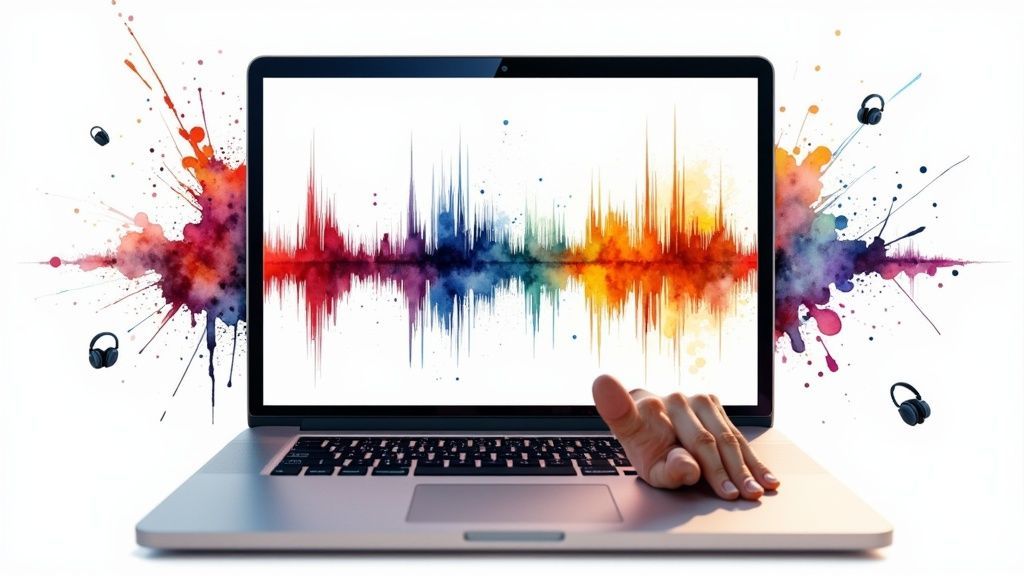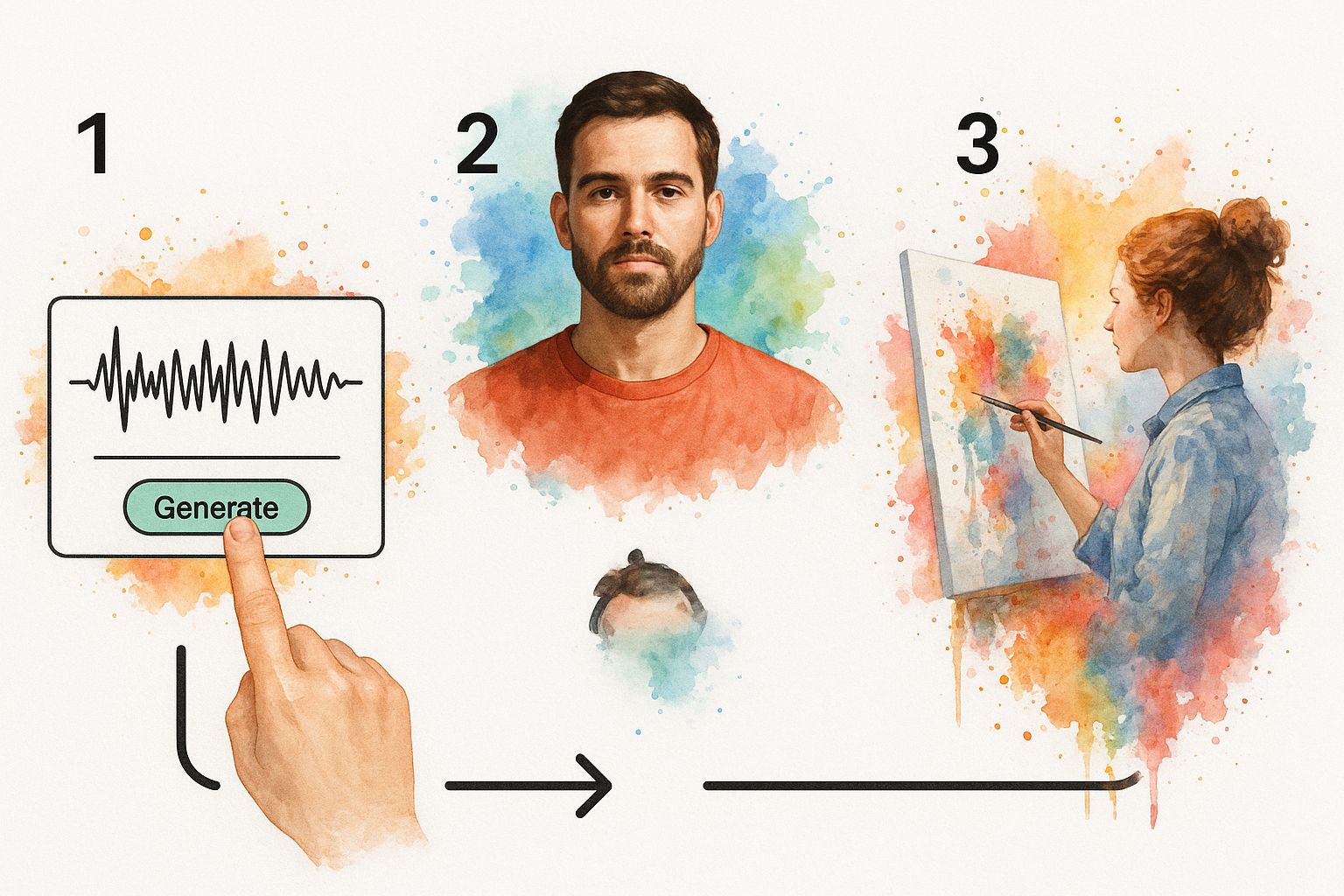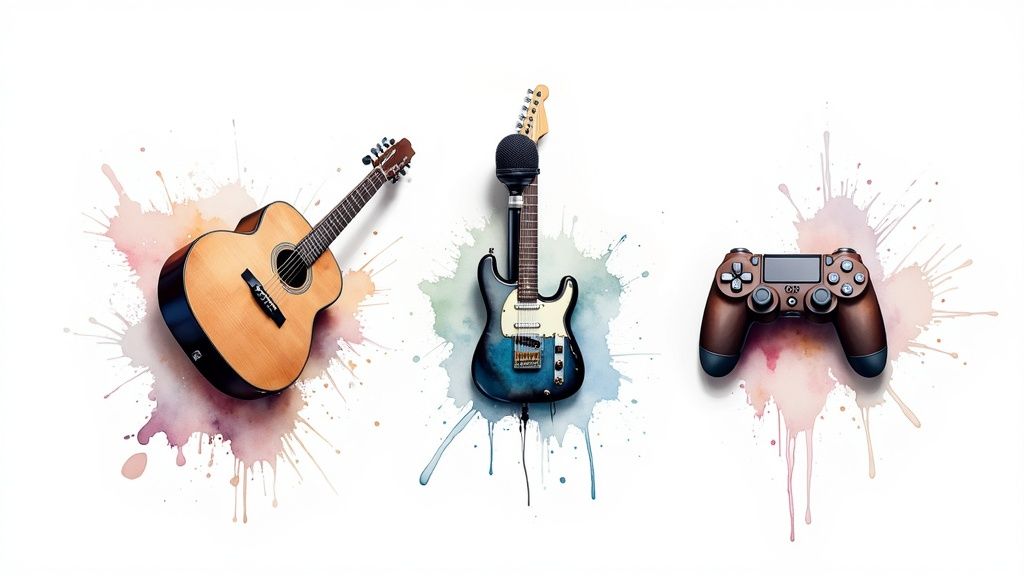
Picture this: you need the perfect sound effect for your project. Maybe it's the low, ambient hum of a distant starship for your indie film, or the distinct crackle of a magical fire for your fantasy game. Now, imagine creating that exact sound yourself, from scratch, in just a few seconds. That’s precisely what a free AI sound generator makes possible, and it’s a tool that goes way beyond basic text-to-speech.
We're going to dive into how these tools are fundamentally changing the game for sound design.

For video creators, game developers, and podcasters, this technology is quickly becoming a go-to resource. It's the answer for anyone who needs unique, royalty-free audio but doesn't have the budget for pricey sound libraries or a foley artist. This guide will show you a practical way to use AI to get professional-grade sound, making high-quality audio accessible to everyone. To really get a sense of its power, it helps to see how it fits into the broader world of general AI content generators.
The demand for these tools is exploding. In 2023, the global AI voice and sound generation market was already valued at USD 3.5 billion. By 2030, it's expected to soar past USD 21.75 billion, thanks in large part to the needs of the media and entertainment industries.
Key Takeaway: AI sound generators aren't just a novelty. They are serious production tools that put the power of sound design into the hands of individual creators—capabilities that used to belong only to big studios.
This is a massive shift. It means you're no longer stuck with the same generic, overused stock audio clips everyone else is using. You can finally craft the exact sound you’re imagining. Whether you're a filmmaker trying to build atmosphere or a podcaster who needs custom stings and transitions, a free AI audio generator gives you an incredible amount of flexibility.
Here's why that’s a big deal for your projects:
So, you're ready to find an AI sound generator, but the sheer number of options can feel a bit overwhelming. With new tools launching all the time, how do you pick the right one without getting lost? Instead of bouncing from one platform to another, it's smarter to go in with a clear idea of what separates the good from the genuinely useful.
Let's break down what really matters.
Your first priority should always be the quality of the sound itself. Don't just take the website's word for it—listen to the samples. Do they sound clean, rich, and authentic? Or can you hear that tell-tale digital fuzz or a muffled, unrealistic quality? High-quality tools will often let you download lossless WAV files, not just compressed MP3s.
Beyond pure quality, think about creative freedom. Some generators are pretty basic, but the best ones let you get incredibly specific. You want a tool that understands complex prompts. Can you ask for "a heavy wooden door creaking open in a damp stone cellar" or "a joyful, shimmering magic spell"? The more detailed control you have, the closer you'll get to the exact sound in your head.
This is where you need to read the fine print. "Free" rarely means unlimited. Take a close look at what the free plan actually gives you. Is it a handful of credits to generate a few sounds per month? Or is it a time-based trial? Understanding these limits upfront will save you from hitting a surprise paywall right in the middle of a project.
The most crucial detail, hands down, is the licensing. A cool sound effect is completely useless if you can't legally use it in a monetized project.
Before you generate a single sound, confirm the platform offers a 100% royalty-free commercial license. This is non-negotiable if you're a YouTuber, game developer, or podcaster. You need ironclad permission to use the audio without worrying about future fees or complicated attribution rules. Get in the habit of scanning the terms of service—it's a small step that can prevent massive legal headaches later on.
To give you a head start, here’s a quick comparison of some popular options out there.
This table breaks down the key features of some leading free AI sound generators, helping you see at a glance which tool might be the best fit for your specific needs.
| Tool Name | Best For | Free Tier Limits | Audio Quality | Commercial Use License |
|---|---|---|---|---|
| SFX Engine | Quick, high-quality SFX for content creators | 20 free credits/month | High (WAV & MP3) | Yes, royalty-free |
| AudioCraft by Meta | Open-source experimentation & custom models | No limits (self-hosted) | Variable (depends on model) | Yes (MIT License) |
| AudioLDM 2 | Realistic soundscapes and ambient audio | No limits (self-hosted) | Good to High | Yes (MIT License) |
| ElevenLabs SFX | Voice-focused actors and narrative projects | 10,000 characters/month | High (MP3) | Yes, with attribution |
Ultimately, the "best" tool depends on your project. For quick, high-quality effects with a clear commercial license, a tool like SFX Engine is a fantastic starting point. For those who are more technical and want to dive deep, an open-source model might be the way to go. Use this guide as your checklist, and you'll find the perfect audio partner for your creative work.
Alright, this is where the fun begins—turning your ideas into actual sound. The heart of any decent AI sound generator lies in how well it can understand what you're asking for. The secret isn't about being a technical wizard; it's about learning to speak the AI's language through your text prompts.
Vague descriptions get you vague results. If you just type in "door sound," you'll get exactly that: a generic, forgettable clip. It works, sure, but it has no personality. The real power comes from adding descriptive layers that paint a vivid picture for the AI.
You have to think more like a writer or a foley artist here. Instead of just "door sound," what's the story behind it? A far more effective prompt would be something like: "A heavy, ancient wooden door creaking open slowly in a large, echoing stone hallway."
See the difference? This prompt gives the AI specific details to chew on:
These little details are what give the final sound effect its texture, depth, and atmosphere. For a deeper dive into crafting these kinds of prompts, we've put together a guide on how to create sounds with precision that covers more advanced techniques.
The image below gives you a nice visual breakdown of this creative loop, from your initial idea to the final soundwave.

As you can see, hitting "Generate" is just one step. The real art is in writing, listening, and then tweaking your prompts until you get exactly what you're hearing in your head.
Once you’ve settled on a descriptive prompt, the rest is pretty simple. You just pop it into the text box, adjust any settings like the sound's duration, and hit the generate button.
My Advice: Don't get discouraged if the first result isn't perfect. I almost always generate a few versions of the same sound. Sometimes a tiny change to the prompt or even just running the exact same one again can yield a much better result. It's part of the process.
Here’s a look at a typical, clean interface. The focus is squarely on your text input.

After a few seconds of processing, the platform will give you the finished audio file. You’ll usually see a waveform and have options to either play it back or download it. Good tools like SFX Engine will offer both MP3 and WAV formats, giving you flexibility for your project. The whole process, from a spark of an idea to a usable, royalty-free sound file on your computer, can take just a couple of minutes.
Alright, let's move past the basics. Simple prompts are fine for getting started with a free AI sound generator, but if you're chasing truly professional-sounding audio, you need to get more specific. The real magic happens when you learn how to layer your ideas and dictate the fine details.
Think of it this way: instead of just asking for a "robot walking," you'll get a much more immersive result with a prompt like "a heavy bipedal robot walking on wet pavement with a faint electrical hum and rusty joints." See the difference? We've combined the core action with the environment and specific character traits, giving the AI a much clearer picture to work with.
Don't expect the perfect sound on the first go. That almost never happens, and that's okay. The real skill is learning how to listen to what the AI gives you, figure out what's missing, and then tweak your prompt to get closer to what's in your head.
If a sound effect falls flat, ask yourself why.
This back-and-forth process is where you really learn. Each generation is a clue. Use it to refine your language, and you'll nail the sound you're looking for much faster.
The ability to quickly create and adjust audio like this is a game-changer for creators. It’s a big reason why the AI voice generator market is projected to explode from USD 4.9 billion in 2024 to an estimated USD 54.54 billion by 2033. Faster production is in high demand.
Here’s a common trap I see people fall into: making prompts too complex. If you throw a whole scene at the AI, like "a dragon flying, roaring, breathing fire, and crashing through a castle wall," it's going to get confused. The model might latch onto one part and ignore the others.
A much better approach is to break it down. Generate the dragon's roar, then the whoosh of its wings, the crackle of fire, and finally the castle wall crumbling. You can then layer these separate, high-quality sounds yourself in any audio editor for complete control.
Ultimately, getting great results from an AI sound engine comes down to your prompting skills. If you want to dig deeper into the general principles, there are some great guides on how to write effective AI prompts for better results. It all comes down to practice and learning how to translate your creative vision into clear instructions.

Okay, so you've used a free AI sound generator to create the perfect audio clip. That's a great start, but the job isn't quite done. Now comes the fun part: actually making it fit seamlessly into your project.
Even the best AI-generated sound effect usually needs a little fine-tuning before it's ready for an audience. Think of it like a raw ingredient that needs a bit of prep to really shine in the final dish. A few simple editing tricks can elevate a good sound into a great one.
You don’t need a fancy studio or years of experience as a sound engineer to get this right. Most of the time, it just comes down to a few fundamental tweaks. For instance, nearly every sound you generate will have a bit of unwanted silence at the beginning or end. Cleaning that up is an easy win.
I typically use free tools like Audacity or the built-in audio editor in CapCut for this. These programs are more than capable of handling the essentials. For a podcast intro, I might take a custom musical jingle from the AI and layer it with a subtle "swoosh" effect I also generated. The combination feels much more dynamic and unique.
Here are the non-negotiable edits I make on almost every clip:
Here's a pro tip I've learned from experience: always work with WAV files during editing. They're uncompressed, so you're working with the highest possible quality. Once you're completely finished and ready to publish, you can then export to a more web-friendly MP3.
Getting comfortable with this process is becoming a key skill for all kinds of creators. The AI audio market is booming—it's projected to hit USD 10.9 billion by 2027. Being able to quickly generate and polish custom audio is what will set your work apart. If you're interested in the business side of this trend, you can review the full market analysis to see how it’s shaking up the media industry.
So, you're ready to jump into a free AI sound generator, but you've got a few questions. That's completely normal. Most creators I talk to are curious about the legal stuff, how to get better-sounding audio, and where the real-world limits are. Let's clear up some of the most common questions.
I'll start with the big one that's usually on everyone's mind.
For the most part, yes, but it’s a good habit to always double-check the specific tool's Terms of Service. A reputable generator like SFX Engine will grant you a broad, royalty-free license. This means you're clear to use the sounds in your monetized YouTube videos, podcasts, or indie games without worrying about future fees.
Where you need to be careful is with the fine print. Some platforms might not let you, for example, package and resell their raw sound files as a standalone SFX library. A quick five-minute scan of the license agreement before you commit a sound to a major project is just smart practice.
Getting great results is all about the quality of your prompts. You have to be incredibly descriptive. Don't just ask for a "car."
Instead, try something with more flavor, like "a vintage muscle car engine idling roughly on a cold morning." The more you can paint a picture with your words—using adjectives for texture, environment, and even emotion—the more the AI has to work with.
My Go-To Tip: Never settle for the first thing you get. I always generate a handful of variations for any sound I need. The AI can be a bit unpredictable, so that fourth or fifth attempt might just be the one that clicks. A little cleanup in an audio editor afterward can also turn a good sound into a great one.
If you try to generate a whole battle scene with a single, massive prompt, you're probably going to be disappointed. Current AI models tend to get overwhelmed and produce a jumbled, muddy mess when asked to create a full soundscape at once.
The secret is to think like a professional sound designer: build your scene layer by layer. For that battle, you'd generate each element individually.
Once you have these separate audio files, you can layer them in your video or audio editor. This gives you way more control over the final mix and leads to a much richer, more believable result.
Ready to start making your own unique audio? Give SFX Engine a try and see just how easy it is to generate custom, royalty-free sound effects in seconds.